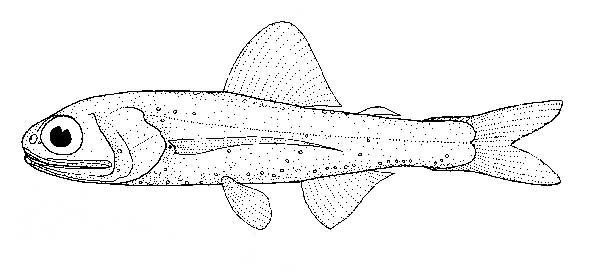The deep sea is a realm of mystery, and one of its most enigmatic inhabitants is the lanternfish. Despite their small size and inconspicuous appearance, these tiny fish play a crucial role in the ocean’s ecosystem. In this article, we will dive into the world of lanternfish, exploring their intriguing behaviors, their impact on the global carbon cycle, and the potential risks associated with their exploitation.

The Deep Scattering Layer and Early Discoveries
At the beginning of the 20th century, echo-sounding technology revealed a puzzling phenomenon called the “deep scattering layer.” Researchers initially speculated that it might be sandbanks or the ocean floor. However, the truth turned out to be far more intriguing. The deep scattering layer was found to be a vast and continuous layer of marine organisms. Dive into the early discoveries surrounding this phenomenon and its significance for naval operations and scientific curiosity.
The Astonishing Vertical Migrations of Lanternfish
The daily vertical migrations of lanternfish are a breathtaking spectacle. These small fish undertake an epic journey each night, ascending from the dark depths to the surface to feed on zooplankton. Discover the factors driving these migrations, such as predator avoidance and feeding opportunities. Scientists have found that these migrations not only affect the lanternfish population but also have significant implications for the entire oceanic ecosystem.
Bioluminescence: The Illuminating Abilities of Lanternfish
One of the most fascinating features of lanternfish is their bioluminescence. Explore the bioluminescent organs known as photophores, which enable these fish to produce light. Learn how they use this ability for various purposes, from attracting mates and luring prey to avoiding detection by predators. Bioluminescence in lanternfish is not only captivating but also serves as a survival strategy in the dark depths of the ocean.
Lanternfish and the Ocean’s Food Web
Despite their size, lanternfish are an essential component of the ocean’s food web. Delve into their role as a primary food resource for numerous marine predators, including sharks, dolphins, and whales. Understand how the population dynamics of lanternfish influence the health and stability of the entire marine ecosystem, making them a linchpin species in the vast oceanic web of life.
The Hidden Carbon Cycle of the Mesopelagic Zone
The mesopelagic, or twilight zone, remains one of the least explored parts of the ocean. However, recent research has shed light on its vital role in the global carbon cycle. Learn about the biological pump and how lanternfish contribute to carbon storage and redistribution in the ocean. This deep-sea carbon sequestration process has far-reaching implications for climate change and the overall health of our planet.
The Carbon-Sequestering Powers of Vertical Migrations
Intriguingly, the vertical migrations of lanternfish and other mesopelagic organisms actively transport carbon into the deep ocean. These migrations remove significant amounts of carbon from the atmosphere, contributing to carbon sequestration. Delve into the research behind this process and its potential impact on mitigating climate change. Understanding this carbon transport mechanism is crucial for comprehending the intricate interactions within Earth’s climate system.
Balancing Exploitation and Conservation
As demand for marine protein rises, the potential for large-scale exploitation of the mesopelagic community increases. Examine the challenges of sustainable fishing practices in the deep sea and the potential consequences of overexploitation. Responsible fisheries management and conservation efforts are essential to preserve the delicate balance of the deep-sea ecosystem and protect its invaluable contributions to Earth’s carbon cycle.
Conclusion
The lanternfish, a seemingly ordinary fish, holds the key to understanding the complexities of the deep ocean and its vital role in the planet’s ecosystem. As we delve further into the mysteries of the mesopelagic zone, it becomes evident that sustainable management and conservation efforts are crucial to preserving this delicate balance and safeguarding the future of our oceans. Understanding and protecting these unsung heroes of the deep sea is a critical step in maintaining the health and resilience of Earth’s oceans for generations to come.
